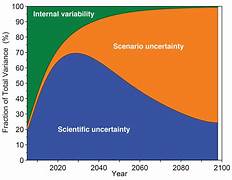Climate Change Projections: A Deep-Dive Into Uncertainty Analysis
Climate change is one of the most pressing global challenges of our time. With its potential to impact ecosystems, economies, and human societies on an unprecedented scale, it is crucial to understand the likely future scenarios that could unfold. While the scientific community agrees on the fundamental principles of climate change—such as the role of human activities in increasing greenhouse gas emissions—predicting the precise extent and timing of these changes is far from straightforward. Climate change projections are inherently uncertain, and understanding the sources of this uncertainty is key to preparing for and mitigating its effects. This article explores climate change projections in detail, focusing on the concept of uncertainty analysis and its role in shaping our understanding of future climate scenarios.
The Basics of Climate Change Projections
Climate change projections are predictions about how the Earth’s climate might evolve under different scenarios in the coming decades or centuries. These projections rely on complex climate models that simulate the Earth’s climate system, including the atmosphere, oceans, land surfaces, and ice sheets. These models take into account various factors such as greenhouse gas emissions, natural climate variability, and feedback mechanisms within the climate system.
To generate climate projections, scientists use a range of scenarios, often referred to as Representative Concentration Pathways (RCPs) or Shared Socioeconomic Pathways (SSPs). These pathways represent different levels of greenhouse gas emissions based on factors like economic development, population growth, and technological advancements. For example, the RCP 2.6 scenario assumes substantial mitigation efforts, while the RCP 8.5 scenario assumes that emissions continue to rise unabated.
Climate projections typically focus on key metrics such as global average temperature, sea level rise, and precipitation patterns. These projections are essential for guiding policy decisions, helping communities prepare for future impacts, and understanding the potential risks and opportunities that may arise in a changing climate.
Sources of Uncertainty in Climate Change Projections
Uncertainty is a fundamental aspect of climate change projections. While scientists have a solid understanding of the processes driving climate change, predicting the exact outcomes is challenging due to a variety of factors. Understanding these uncertainties is crucial for interpreting climate projections and making informed decisions about climate action. The sources of uncertainty in climate change projections can be broadly categorized into three main types: model uncertainty, scenario uncertainty, and natural variability.
1. Model Uncertainty
One of the primary sources of uncertainty in climate projections is model uncertainty. Climate models are complex mathematical representations of the Earth’s climate system. These models rely on physical laws to simulate the interactions between the atmosphere, oceans, land, and ice. However, the climate system is highly complex and not fully understood, which means that models are based on a range of assumptions and simplifications.
Key areas of model uncertainty include:
- Resolution of the Model: Climate models operate at different spatial and temporal resolutions, meaning that the smaller and more detailed the model’s grid, the more computationally expensive it becomes. Lower-resolution models may not capture smaller-scale features of the climate system, such as local weather patterns or the behavior of specific ecosystems.
- Representation of Physical Processes: Some physical processes, such as cloud formation, ocean circulation, and the melting of ice sheets, are difficult to simulate accurately. Small differences in how these processes are represented in models can lead to significant differences in climate projections.
- Feedback Mechanisms: Climate models also include feedback mechanisms—interactions that either amplify or dampen climate change. For example, the melting of ice reduces the Earth’s reflectivity, leading to more solar energy being absorbed, which in turn accelerates warming. However, the exact strength of these feedbacks is uncertain and varies across different models.
- Model Parametrization: Many processes in climate models cannot be directly simulated and instead require assumptions or approximations, known as parametrizations. The choice of parametrization can introduce uncertainty into the model’s projections.
2. Scenario Uncertainty
Another major source of uncertainty arises from the assumptions made about future greenhouse gas emissions, land-use changes, and other socio-economic factors. Different emissions scenarios, such as RCPs or SSPs, represent a wide range of possible futures based on varying assumptions about human behavior, technological advancements, and policy decisions. Since it is impossible to predict exactly how human societies will evolve, the future trajectory of emissions remains highly uncertain.
Some key sources of scenario uncertainty include:
- Economic Growth and Technological Development: Climate projections often depend on assumptions about economic growth, energy consumption, and technological progress. For instance, an optimistic scenario with rapid advances in renewable energy technology might lead to lower emissions, while a scenario with continued reliance on fossil fuels would result in higher emissions. The rate at which new technologies are adopted or how quickly societies transition to greener practices significantly affects future emissions.
- Population Growth and Urbanization: The size and distribution of the global population, as well as the rate of urbanization, influence future greenhouse gas emissions. A larger, wealthier population tends to consume more energy, which can lead to higher emissions. However, urbanization also offers opportunities for more energy-efficient infrastructure and sustainable development practices.
- Policy Decisions and Mitigation Efforts: Climate policies and mitigation efforts, such as the implementation of carbon pricing, renewable energy mandates, and international climate agreements, can significantly influence emissions trajectories. The level of ambition and the effectiveness of such policies are highly uncertain and have a substantial impact on climate projections.
- Land Use Changes: Deforestation, afforestation, and agricultural practices are also key contributors to future emissions. The extent to which land-use changes occur will depend on economic and policy decisions, making it difficult to predict how the land sector will evolve.
3. Natural Variability
In addition to human-driven factors, natural variability in the climate system adds another layer of uncertainty to projections. The Earth’s climate is influenced by natural factors such as volcanic eruptions, solar radiation, and ocean circulation patterns. While scientists have made significant progress in understanding these natural processes, they remain inherently unpredictable in the short term.
Some sources of natural variability include:
- Volcanic Eruptions: Large volcanic eruptions can inject huge amounts of aerosols into the atmosphere, temporarily cooling the Earth by reflecting sunlight away from the surface. These events can have a significant short-term impact on global temperature but are difficult to predict in advance.
- Solar Cycles: The Sun’s energy output varies over an approximately 11-year cycle. While solar radiation has a relatively small effect on long-term climate trends, fluctuations in solar activity can influence short-term climate variability.
- Ocean-Atmosphere Interactions: Phenomena such as El Niño and La Niña, which are driven by changes in ocean temperatures, can lead to significant changes in global weather patterns. These events can alter regional climates and contribute to fluctuations in temperature, precipitation, and storm activity.
4. Uncertainty in Ice Sheets and Sea-Level Rise
One of the most uncertain aspects of climate change projections is the contribution of ice sheets to sea-level rise. Ice sheets in Greenland and Antarctica are melting at an accelerated pace due to rising temperatures. However, predicting how much ice will melt and how quickly it will contribute to sea-level rise is extremely difficult. Feedback mechanisms such as the destabilization of ice shelves and the flow of glaciers into the sea add to the complexity of these projections.
Communicating Uncertainty in Climate Projections
While uncertainty is inherent in climate projections, it is important to communicate this uncertainty clearly to policymakers and the public. One approach is to present projections as ranges rather than absolute predictions. For example, a temperature projection might be expressed as a range of possible outcomes, such as “global temperatures will increase by 1.5 to 4°C by the end of the century, depending on emissions scenarios and model assumptions.”
Another approach is to use probabilistic methods, where scientists estimate the likelihood of different outcomes based on various scenarios. This helps to convey not just the potential range of future conditions but also the likelihood of different outcomes, providing a more nuanced picture of future climate risks.
Conclusion
Climate change projections are essential tools for understanding the potential impacts of global warming and guiding efforts to mitigate and adapt to its effects. However, these projections come with inherent uncertainties due to factors such as model limitations, scenario assumptions, and natural variability. While uncertainty can complicate decision-making, it should not lead to paralysis or inaction. Instead, acknowledging uncertainty should prompt us to adopt more flexible, adaptive policies and strategies that are robust under a wide range of possible futures. By addressing uncertainty head-on, we can better prepare for the challenges of climate change and work toward a more sustainable future.


